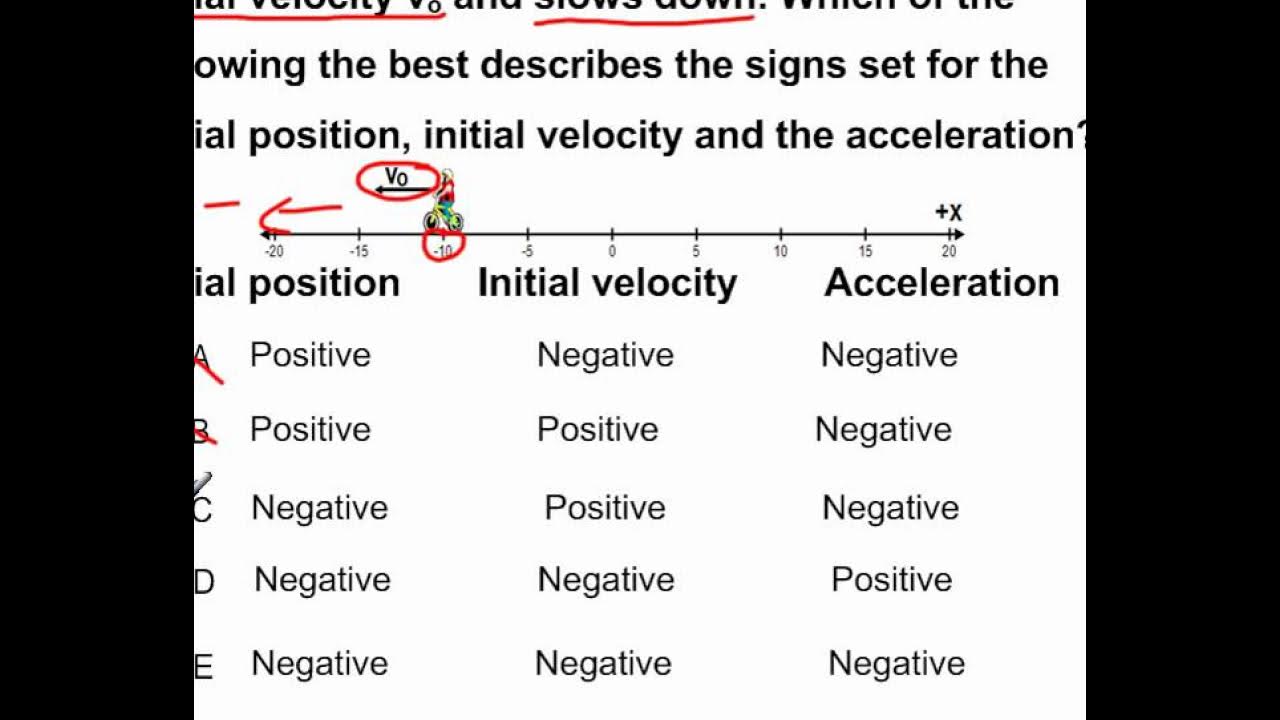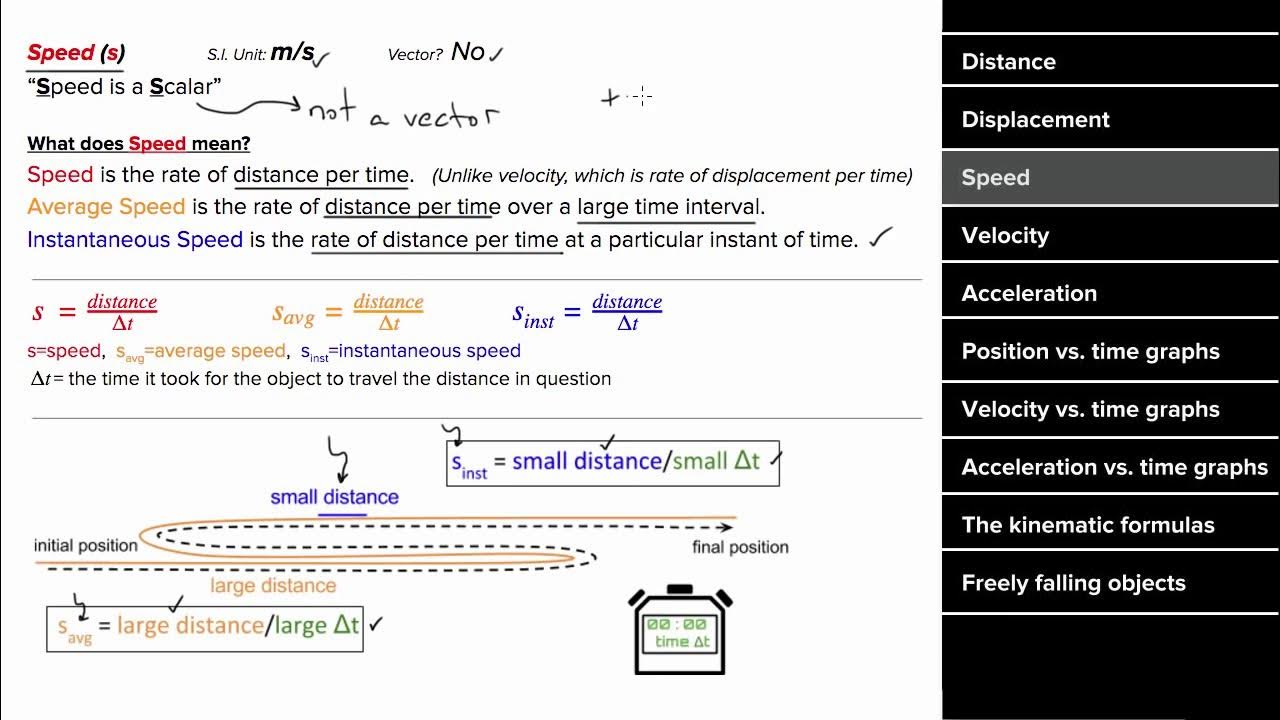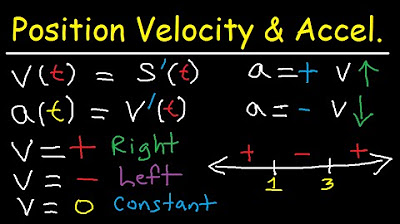AP Calculus AB - Straight Line Motion
TLDRThe video script delves into the physics of straight-line motion, focusing on the relationship between position, velocity, and acceleration over time. It begins with a position-time graph, illustrating an object starting at a positive four meters and moving to 2.8 meters in about 1.2 seconds. The object's motion is characterized by a backward movement, a stop, and then a forward progression. The velocity, derived from the position function, is shown to transition from negative to zero and then to positive, indicating a change in direction. The acceleration, as the second derivative of the position function, is determined to be a linear function. The script emphasizes understanding the direction of motion and the concept that velocity is a vector quantity with direction, while speed is a scalar. Finally, the script applies these principles to calculate the velocity and acceleration of a particle at specific time points, using derivatives to analyze the motion and direction of the particle's movement.
Takeaways
- 📍 The position-time graph represents an object's position with respect to time, with the x-axis for time and the y-axis for position in meters.
- 🔄 An object's motion can be analyzed by observing changes in its position over time, indicating whether it's moving forward or backward.
- 📈 Velocity, the rate of change of position with respect to time, is derived from the position function and can be represented graphically to show direction and speed changes.
- ⏹ A velocity of zero indicates that the object is momentarily at rest before changing direction.
- 🚀 Acceleration is the rate of change of velocity with respect to time, obtained by taking the second derivative of the position function.
- ↗️ When the velocity-time graph shows a transition from negative to positive, it signifies a change in the direction of motion from backward to forward.
- 📉 Negative velocity indicates the object is moving in the reverse direction, while positive velocity means it's moving forward.
- 🏃 Speed is a scalar quantity that only considers magnitude, whereas velocity is a vector quantity that includes both magnitude and direction.
- 📊 The shape of the position, velocity, and acceleration graphs can be used to interpret the motion of an object over time, with each successive derivative representing a different aspect of motion.
- ⏳ At any given instant, the slope of the tangent on the position-time graph represents the instantaneous velocity, and the slope of the tangent on the velocity-time graph represents the instantaneous acceleration.
- 🔢 To find the velocity or acceleration at a specific time, substitute that time into the derived velocity or acceleration function, respectively.
Q & A
What is the initial position of the object in the given physics example?
-The initial position of the object is at positive 4 meters away from the reference point.
What does it mean when the position-time graph of an object shows a decrease in position from 4 meters to 2.8 meters?
-It means the object is moving backwards, as the position is decreasing over time.
What is the relationship between velocity and position with respect to time in the context of the script?
-Velocity is the derivative of the position function with respect to time, which means it represents the rate of change of position at any given time.
How does the velocity-time graph indicate the direction of motion of the object?
-A negative velocity indicates the object is moving backwards, a velocity of zero indicates the object is momentarily at rest, and a positive velocity indicates the object is moving forwards.
What is the difference between speed and velocity?
-Speed is a scalar quantity that refers to the magnitude of motion, while velocity is a vector quantity that includes both the magnitude and direction of motion.
How does the acceleration function relate to the velocity function?
-Acceleration is the derivative of the velocity function with respect to time, indicating the rate of change of velocity.
What is the significance of the acceleration being a linear function in the script?
-The linear nature of the acceleration function implies that the rate of change of velocity is constant over time, which is typical in scenarios with constant forces applied.
What does it mean when the acceleration is negative?
-A negative acceleration means that the object is decelerating, or its velocity is decreasing over time.
At what value does the velocity of the object become zero according to the script?
-The velocity of the object becomes zero at approximately 1.2 seconds, indicating the object momentarily stops before changing direction.
How can one determine the particle's velocity at a specific time using the position function?
-One can determine the particle's velocity at a specific time by taking the derivative of the position function and then evaluating it at the desired time.
What is the particle's velocity at time equals two seconds in the example provided?
-The particle's velocity at time equals two seconds is negative one meter per second, indicating the particle is moving to the left.
How can the direction of the particle's motion be inferred from the velocity value?
-If the velocity value is negative, the particle is moving in the negative direction (to the left if considering the x-axis), and if it's positive, the particle is moving in the positive direction (to the right on the x-axis).
Outlines
📈 Understanding Position, Velocity, and Acceleration in Physics
The first paragraph introduces the concept of straight-line motion in physics, focusing on the position function with respect to time. It explains how the position-time graph can be used to determine the movement of an object, including its direction and speed. The velocity, which is the derivative of the position function, is discussed in detail, showing how it can be negative (indicating backward movement) or positive (forward movement). The paragraph also covers how acceleration, the second derivative of the position function, can be calculated and interpreted. It provides an example of how to find the velocity and acceleration at specific points in time using derivatives.
📊 Interpreting Graphs of Motion: Position, Velocity, and Acceleration
The second paragraph delves into interpreting graphs of motion, emphasizing the importance of understanding whether a graph represents position, velocity, or acceleration over time. It explains how to read the graphs to determine the direction and speed of an object's movement. The paragraph illustrates how the slope of the tangent on a velocity-time graph indicates the acceleration at a particular instant. It also discusses how to find the velocity and acceleration at specific times by taking derivatives of the position and velocity functions, respectively.
🚀 Applying Derivatives to Analyze Straight-Line Motion
The third paragraph continues the discussion on straight-line motion, focusing on the application of derivatives to analyze an object's movement. It describes how the direction of motion and the particle's speed can be determined from the velocity and acceleration. The paragraph provides an example calculation to find the velocity and acceleration at specific times, highlighting the process of taking derivatives. It concludes by emphasizing the simplicity of the process, which involves taking derivatives to transition from position to velocity to acceleration.
Mindmap
Keywords
💡Position function
💡Velocity
💡Acceleration
💡Derivative
💡Power rule
💡Tangent slope
💡Scalar vs. Vector
💡
💡Direction of motion
💡Instantaneous point
💡Cubic function
💡Quadratic function
Highlights
Introduction to physics applications in AP Calculus AB focusing on straight-line motion.
Explanation of position function with respect to time, using a graph with position on the x-axis and time on the y-axis.
Demonstration of an object moving backwards and then forwards, shown through changes in the position-time graph.
Derivation of velocity with respect to time as the change in position over time, using the power rule.
Interpretation of the velocity graph, including the significance of negative velocity indicating backward motion.
Differentiation between speed and velocity, emphasizing that velocity is a vector quantity with direction.
Calculation of acceleration as the second derivative of the position function with respect to time.
Graphical representation of how acceleration changes from negative to positive, indicating a change in direction.
Identification of when an object has stopped by the velocity being zero, as shown on the velocity-time graph.
Explanation of how a velocity-time graph can indicate whether an object is moving forward or backward.
Use of derivatives to transition from position to velocity to acceleration in the context of straight-line motion.
Example calculation of a particle's velocity at a specific time using the derived velocity function.
Determination of a particle's acceleration at a given time by differentiating the velocity function.
Analysis of the direction of a particle's motion based on the sign of its velocity.
Calculation of a particle's speed and its implications on the velocity and acceleration.
Comprehensive overview of the physics of straight-line motion using calculus derivatives.
Transcripts
Browse More Related Video

AP Physics B Kinematics Presentation #81

Worked example: Motion problems with derivatives | AP Calculus AB | Khan Academy

Motion problems: when a particle is speeding up | AP Calculus AB | Khan Academy

AP Physics 1 review of 1D motion

Calculus - Position Average Velocity Acceleration - Distance & Displacement - Derivatives & Limits

How to Match Motion Graphs in Physics
5.0 / 5 (0 votes)
Thanks for rating: